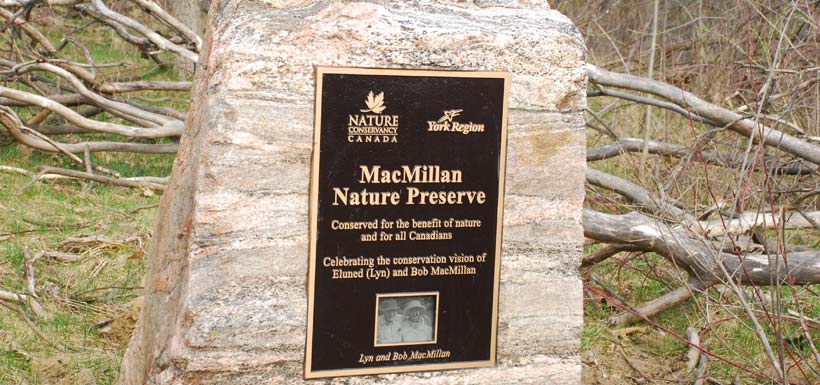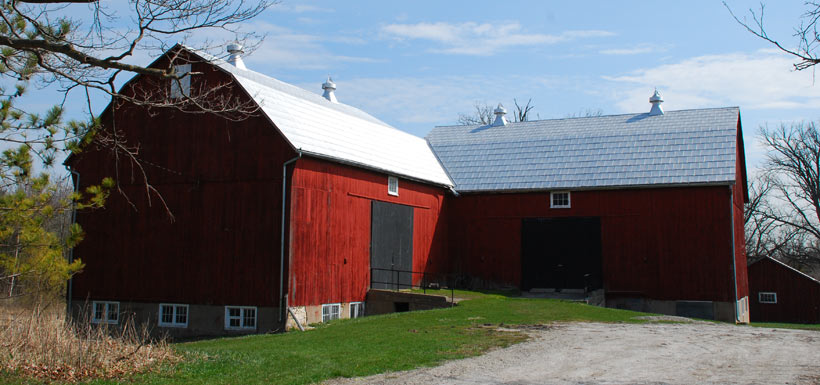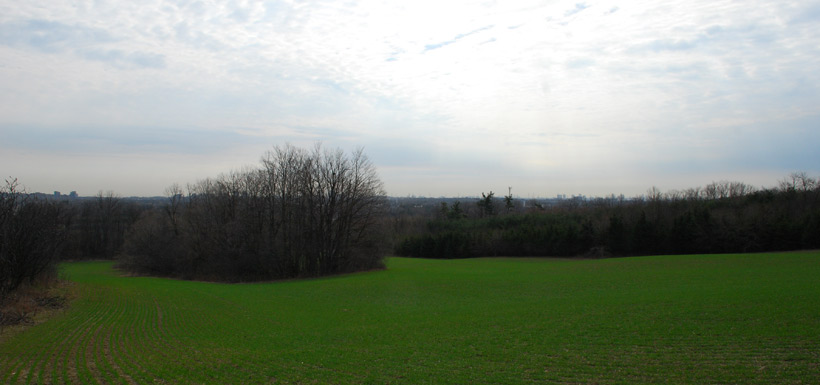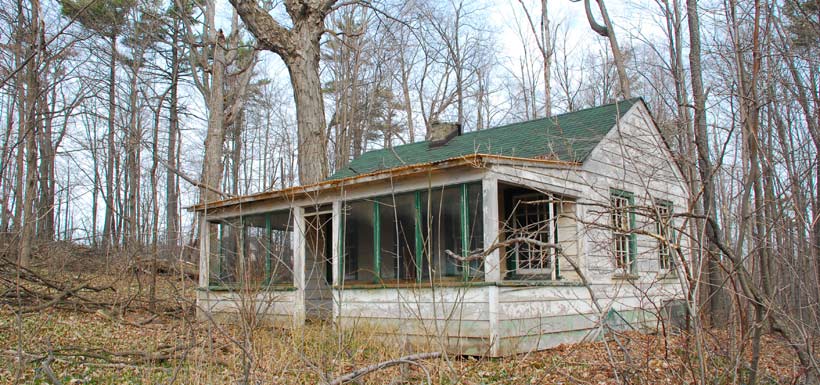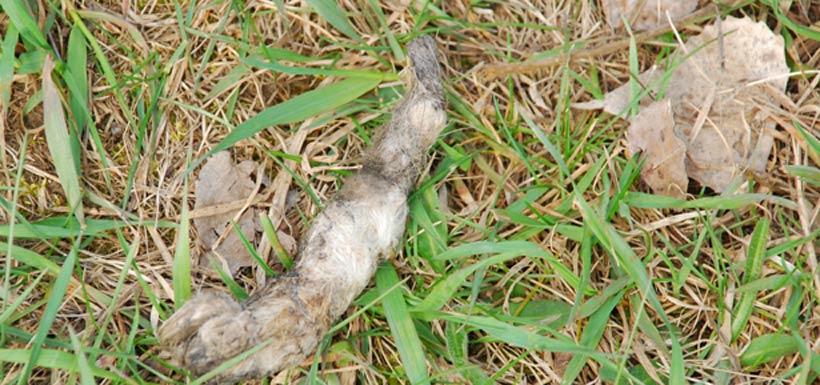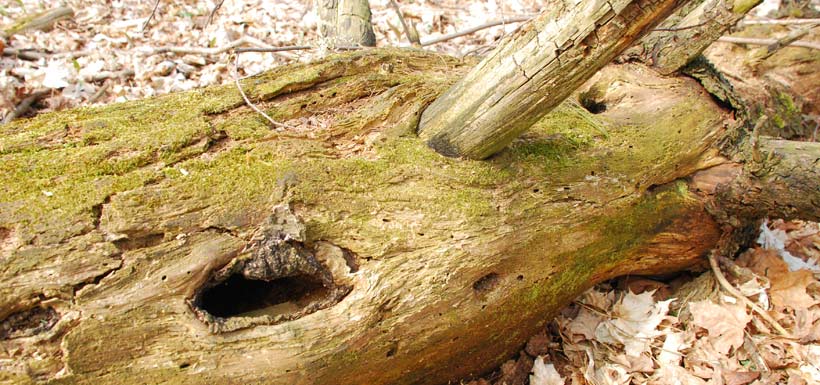A hidden gem in the city of Vaughan
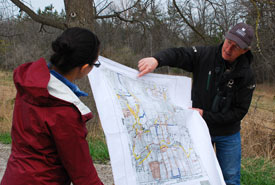
Mark showing the group the geographical features of the area (Photo by NCC)
We’re seeing more reports in the media of nature’s benefits to our health and well-being and the need for communities to reconnect with nature. Private land conservation is at the core of the Nature Conservancy of Canada’s (NCC’s) work and I’ve always worn our vision “to conserve areas of natural diversity in perpetuity” as a badge of pride.
But never have I so felt so personally connected to land conservation until recently, when Mark Stabb, NCC’s Central Ontario program director, invited me to a sneak peak of an upcoming Jane’s Walk (a free, citizen-led event) at a nature reserve just minutes away from my home.
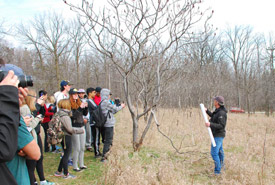
Students gather around as Mark explains the importance of conserving land in its natural state (Photo by NCC)
On April 21, Mark and I had the pleasure to host students from Dunbarton High School, along with David Gordon, who teaches the school’s environmental science program, and Julia Martini, the environmental education coordinator with EcoSpark, at the MacMillan Nature Reserve.
The property is located within the Oak Ridges Moraine and in the heart of Vaughan. Concerned about the spread of development in the Vaughan area, the late Eluned (Lyn) and Robert MacMillan donated a 120-acre (48-hectare) portion of their land to NCC in 2004. Seven years later, the family sold the 40-acre (16-hectare) MacMillan Farm in the middle of the property to the City of Vaughan.
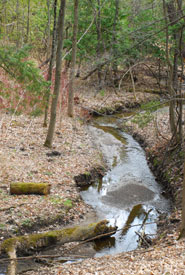
Tributary of the Don River running through the valley (Photo by NCC)
NCC’s property here is mostly left in its natural state, allowing for the succession of plants and life. There are some farm lands currently being leased that will be restored to natural cover in the future as well. Part of the forested area dips into a valley, with the tributary of the Don River running through it.
During our hike on the property, we heard songbirds and woodpeckers, found feathers from wild turkeys and scat from a coyote. Red-tailed hawks and deer can be found on the property.
NCC staff currently monitor and manage the spread of invasive species on the property, including black locust trees, dog-strangling vine, white sweet clover, smooth brome, tartarian honeysuckle and garlic mustard. The goal is to return native vegetation to the land.
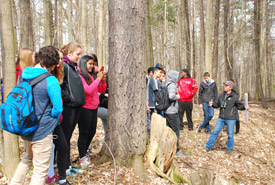
Students listen in as Mark Stabb describes the features of the valley portion of the property (Photo by NCC)
The city is exploring various ways to use the property as public greenspace, with a focus on the rural character of the MacMillan Farm. Ideas have included community garden plots, demonstration farming and outdoor programming. NCC and Vaughan parks staff are discussing ways to collaborate in management of the reserve and city lands together. This includes the development and maintenance of nature trails and interpretive opportunities.
During the hour-long visit, we learned about the natural features of the site, future plans for public engagement and current conservation actions. Following their visit, students each submitted a photo assignment to reflect on the sites they had visited throughout the day. Here is a contribution from Sarah Whitlock of Dunbarton High School:
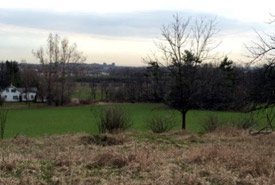
MacMillan Farm (Photo by Sarah Whitlock)
“Our city continues to grow and we are losing the precious green space we have.
“This image demonstrates how our city is developing around farm land.” – Excerpt by Sarah Whitlock, student of Dunbarton H.S.
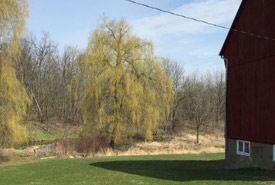
Photo by Sarah Whitlock
“If people realize the need for this type of land, it might help reduce urban sprawl.
“The MacMillan Farm is an example of ecological services; ecological services are something the environment does for humans that we can’t live without. Green areas improve air quality because trees are needed to convert carbon dioxide to oxygen.” – Excerpt by Sarah Whitlock, student of Dunbarton H.S.
EcoSpark’s Julia Martini believes field trips and field studies connect students to the environment: “Inviting [students] to the NCC Macmillan Nature Reserve to learn from the experts and see firsthand what urban sprawl means is something that can't be replicated inside. It's all about making real-world and personal connections with the environment!”
On that note, David says people learn best by doing and feeling. He hopes this tour will teach students to care for local issues while making abstract ideas such as conservation more concrete. He hopes to bring local culture back into focus for their classroom discussions, “because local is immediate and relevant to our well-being and we can actually act to improve and change it.”
I still could not believe there is a well-conserved greenspace in the middle of a bustling city. My hope is more Canadians can have the opportunity to be close to nature and that protected spaces become an integral part of the local community. I, for one, was thrilled to discover MacMillan Nature Reserve a stone’s throw away from home.
I invite you to join conservation experts at MacMillan Nature Reserve’s free Mother’s Day event on the morning of May 8 and discover this rare gem in the Greater Toronto Area. Here is a chance to learn about the natural and cultural history of the property, and also about the conservation legacy of Lyn MacMillan who successfully advocated for the protection of the Niagara Escarpment and other lands.
Click to enlarge the photos in the slideshow.

